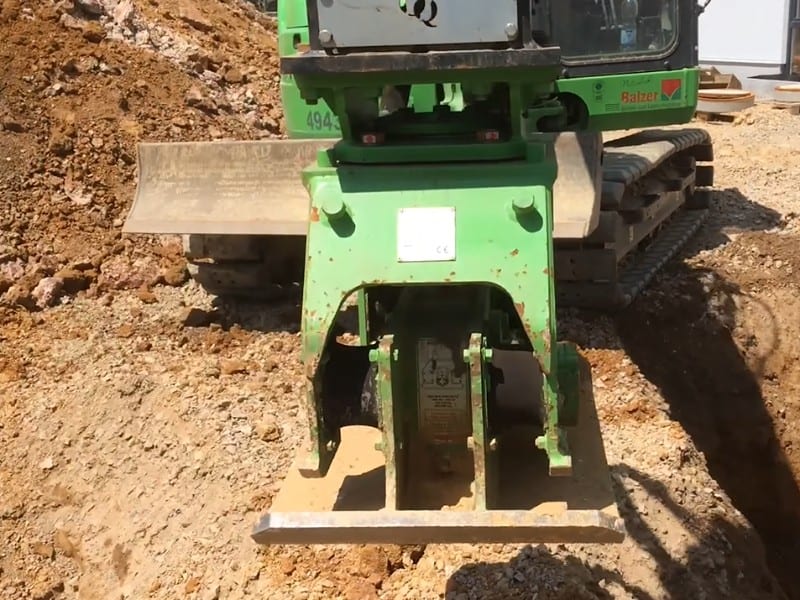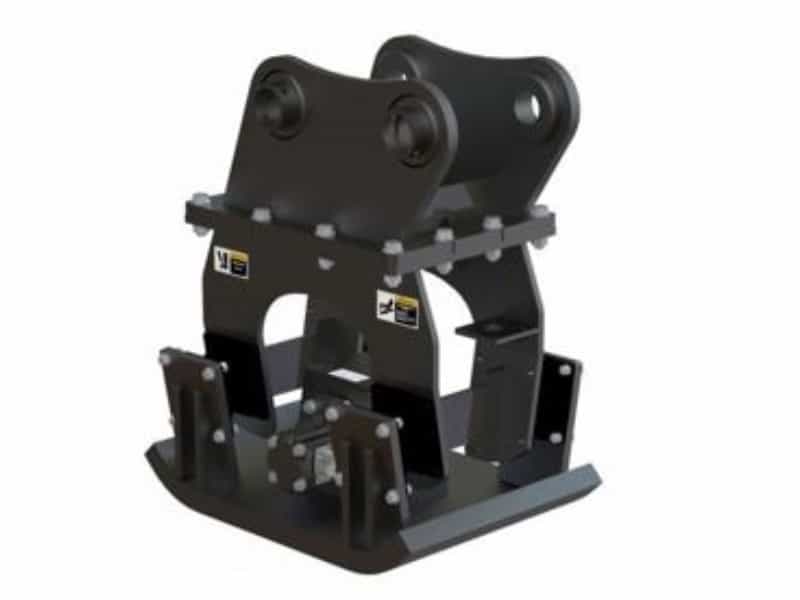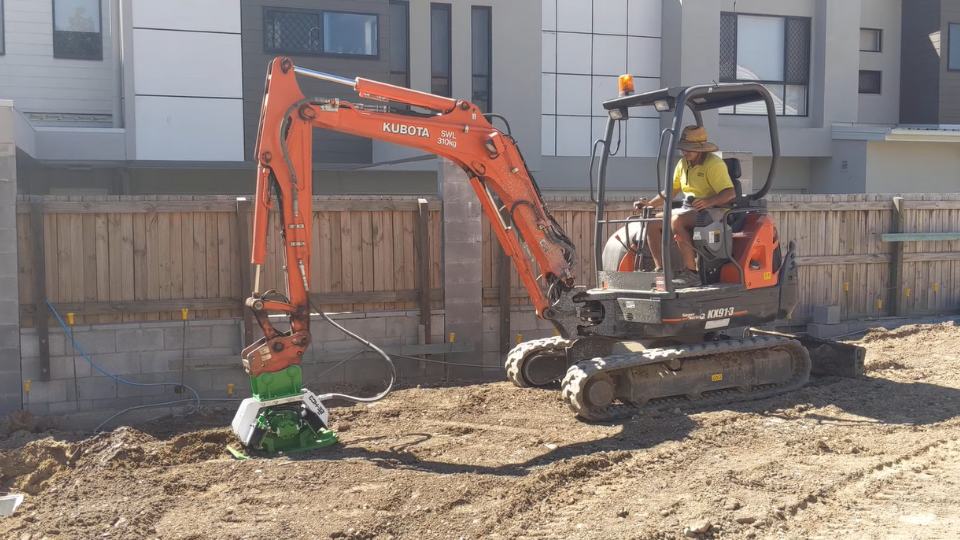Mini excavator compactors are compact and versatile pieces of equipment attached to a mini excavator. It is used to compact soil, sand, gravel, and other materials in tight spaces that are difficult to access with larger equipment. The compactor attachment usually consists of a plate that vibrates rapidly to pack down loose material and create a stable, level surface. It is commonly used in construction, landscaping, and other projects requiring efficient soil or compaction.
These cool trench rollers, some of which come with remote control. Proper soil compaction is an essential requirement in different construction applications. They give numerous options to Professionals for achieving their objective, including upright rammers, reversible plate compactors, forward plate compactors, and trench rollers. However, it is worth considering using a compaction plate attachment on a compact excavator as an effective alternative.

The equipment is useful for trench or hill compaction, and it offers several benefits, such as enhanced safety, good visibility, and extended reach. The use of a machine-operated compactor is safer for work environments. This approach eliminates the need for operators in or near a trench while working, and plate compactors can deliver higher compaction levels within shorter timeframes, increasing productivity. These attachments are particularly useful for pipeline backfills, road or railway slopes, and other areas where self-moving plates or rollers cannot operate. They are also suitable for driving in and pulling out posts, sheet piling, and other formworks.
The compact excavator, a hydraulic plate compactor, comprises four primary components. The bottom plate is wear-resistant steel with an eccentric element that generates the vibration force. A hydraulic motor rotates the eccentric element, which requires pressure and return lines from the carrier and sometimes a case drain line from the motor to the tank, depending on the carrier’s hydraulic system.
The vibrating lower part is mounted on a top frame with rubber pad isolators, including a hydraulic rotation motor or a free rotating plate where the adapter plate is mounted or sometimes bolted directly to the frame. Excavators can use for multiple tasks, including digging a trench.
Moreover, vibratory attachment inside the excavator cab provides several safety advantages. Noise and vibration are minimized compared to operating a walk-behind or handheld unit. Furthermore, the operator can operate the compactor from a safe distance.
Mini excavator compactors types
Several types of mini excavator plate compactors are available in the market; each has unique features and benefits.
Standard Plate Compactors:
These are the most basic type of mini excavator plate compactors. They consist of a bottom plate with an eccentric element, a top frame with rubber pad isolators, and a mounting bracket. They are ideal for compacting loose soil, gravel, and sand.

Reversible Plate Compactors:
These mini excavator plate compactors can move forward and backward, making them ideal for compacting larger areas. They are useful in backfilling trenches, asphalt, and paving soil.

Hydraulic Plate Compactors:
The hydraulic pressure of the excavator powers these mini excavator plate compactors. They have a higher force output than standard and reversible plate compactors, making them ideal for compacting harder materials like clay and rock.
Vibro Plate Compactors:
These mini excavator plate compactors have a vibrating mechanism that oscillates the bottom plate at high frequencies. This vibration helps to increase the compaction force and penetrate deeper into the soil, making it ideal for compacting soil with a high clay content.
Pile Driver Plate Compactors:
These mini excavator plate compactors are designed to drive piles into the ground. They are useful in construction sites where piles must be driven into the ground for foundation support.
Trench Plate Compactors:
These mini excavator plate compactors come to compact the soil in narrow and tight spaces like trenches. They have a narrow bottom plate, making them suitable for working in confined spaces.
Remote-Controlled Plate Compactors:
These mini excavator plate compactors are controlled remotely, making them ideal for working in hazardous areas or areas that are difficult to access.
Furthermore, mini excavator plate compactors offer many features and benefits that make them suitable for construction projects. The type of mini excavator plate compactor depends on the type of soil, the size of the area to be compacted, and the construction project’s specific requirements.
Operating the Mini Excavator Compactor
Positioning the Machine and Compactor:
Before operating the mini excavator compactor:
- Position the machine and compactor in the appropriate location.
- Ensure the compactor is properly attached to the mini excavator and that the carrier weight capacity is sufficient to handle the weight of the compactor.
- Position the machine so that it is perpendicular to the area you need to compact, with the compactor attached to the arm of the excavator.
Adjusting the Vibration and Pressure Settings:
Now, adjust the vibration and pressure settings on the mini excavator compactor. The vibration setting controls the intensity of the vibrations of the compactor, while the pressure setting controls the downward pressure of the compactor on the soil. Adjust these settings according to the type of soil you are compacting and the compaction requirements of your project.
Starting the Compaction Process:
Then you have positioned the machine and adjusted the settings; it’s time to start the compaction process. Start lowering the compactor onto the soil surface, ensuring it is parallel to the ground. Move the machine forward slowly, with the compactor vibrating and exerting downward pressure on the soil. Continue this process until the entire area has been compacted.
Monitoring the Compaction Process:
In compacting the soil, it’s important to monitor the compaction process to ensure that the desired level of compaction is achieved. Check the soil compaction level periodically using a compaction meter or another appropriate device to ensure the desired level of soil density is achieved. Adjust the compactor settings if necessary to achieve the required compaction level.
Finishing the Compaction Process:
Once you have achieved the desired level of soil compaction, lift the compactor off the soil surface and move the machine away from the compacted area. Use a hand tamper or other appropriate tool to compact any remaining areas the mini excavator compactor cannot reach.
Conclusion
Mini excavator compactors are versatile and efficient machines that ensure proper soil compaction in construction projects. Mini excavator plate compactors are preferred for their ease of maintenance, high efficiency, and safety compared to other compacting equipment, including handheld units and walk-behind compactors. If you want to Invest in a mini excavator plate compactor, contact us, it is wise for construction professionals looking to improve productivity, safety, and quality in their projects.

